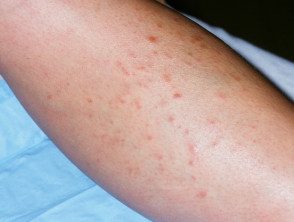What is it hereditary leiomyomatosis and renal cell Cancer syndrome?
Hereditary leiomyomatosis and renal cell cancer syndrome is a rare condition that was first formally recognized in 2001. It is now reported to affect more than 105 families worldwide. Features of the syndrome include:
- Cutaneous leiomyomas
- Uterine leiomyomas
- Uterine leiomyosarcoma
- Renal cell cancers
Hereditary leiomyomatosis and renal cell cancer syndrome is also known as Reed syndrome, multiple cutaneous and uterine leiomyomas type 1, and hereditary leiomyomas and renal cells. carcinoma.
Cutaneous leiomyomatosis

Cutaneous leiomyomatosis

Cutaneous leiomyomatosis

Cutaneous leiomyomatosis
What are the clinical features of hereditary leiomyomatosis and renal cell cancer syndrome?
Cutaneous leiomyoma
Cutaneous leiomyomas or piloleiomyomas appear as small (0.5–2 cm) firm colored skin. nodules. They arise from the arrector pili muscles that are responsible for making your hair stand on end. Multiple lesions may develop, often in groups and commonly in a segmental distribution. These nodules are benign, so they are only a cause for concern because of their appearance or their tendency to be sensitive if bumped.
Occasionally, multiple cutaneous leiomyomas may also arise in association with Gardner syndrome. HIV infection, chronic lymphocytic leukemia and polycythemia.
Uterine leiomyoma
He leiomyoma Uterine is also known as fibroid and is the most common premenopausal. tumor in women In hereditary leiomyomatosis and renal cell cancer syndrome, fibroids occur earlier than usual and are often larger and more likely to cause excessive bleeding and pain with menstruation. Although most are benign, there is an increased risk of malignancy (leiomyosarcoma) developing, and some appear atypical through the microscope
Renal cell carcinoma
Renal cell carcinoma is the most concerning feature of hereditary leiomyomatosis and renal cell cancer syndrome, although this does not occur in all people with the disease. It is believed that only some mutations are associated with the development of renal cell cancer. Unfortunately, the renal cell cancers that develop in this syndrome tend to be aggressive and appear at a young age. Are histologically papillary type 2. Unlike other renal cell cancer syndromes (see von Hippel Lindau syndrome and Birt-Hogg-Dubé syndrome), they are more common unilateral and lonely
What is the cause of hereditary leiomyomatosis and renal cell cancer syndrome?
the gene responsible for hereditary leiomyomatosis and renal cell cancer syndrome has been identified as the fumarate hydratase gene. This gene is believed to act as a tumor suppressor. Fumarate hydratase enzyme It works in the cellular energy pathway called the Krebs cycle. How this causes the clinical features is not fully understood.
Many mutations are known to occur in this gene, all of which result in the syndrome being inherited in a autosomal Dominant fashion. That means that an affected individual can transmit it to approximately half of his or her sons and daughters. Consultation with a geneticist may be advisable given the importance of the participation of other family members.
What is the treatment for the syndrome?
There are no means to repair the gene. mutation. Treatment focuses on cancer detection and prevention.
Current advice is to obtain regular images of the kidneys. It has been suggested that kidney tumors in this syndrome are not seen early ultrasound, then a Magnetic resonance scanning is usually required.
Affected women should seek consultation with a gynecologist, especially if they have heavy bleeding or pain with menstruation. If they have a large fibroid, it may need to be removed for symptomatic reasons. Regular uterine screening should be encouraged. Once they are done having children, they may want to consider hysterectomy (removal of the uterus) to reduce the risk of uterine cancer.
Since hereditary leiomyomatosis and renal cell cancer syndrome are inherited, it is vital that all family members are informed and consulted by a doctor with experience in this area. Genetic testing is available with a simple DNA sample (blood or buccal swab).
Some cases may require treatment for the pain of cutaneous leiomyomas. The following has been reported to be helpful:
- Calcium channel blockers, particularly nifedipine.
- An alpha-adrenoceptor blocker, phenoxybenzamine
- Gabapentin
